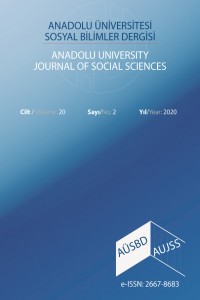Dile Getirme Davranışı (Voice Behavior) Ölçeğinin Türkçe Adaptasyonu: Geçerlik ve Güvenirlik Çalışması
Öz
Dile getirme davranışı son yıllarda birçok araştırma modelinin odaklandığı bir konu haline gelmiştir. Özellikle örgütsel davranış alanında liderlik, motivasyon, bağlılık, aidiyet gibi çeşitli konular ile daha çok gündeme gelen bu kavrama yönelik henüz Türkçe literatürde kullanımı mevcut bir Türkçe ’ye uyarlanmış ölçeğe rastlanılmamıştır. Bu kapsamda mevcut çalışmada, dile getirme davranışı ölçeğinin, Türkçe’ye uyarlanması ve geçerlik-güvenirliğinin test edilmesi amaçlanmıştır. Türkçe literatürde önemli bir boşluğu dolduracağı değerlendirilen çalışmanın örneklemi İstanbul ilinde, çalışmaya katılmayı kabul eden 4 özel hastaneden, yöneticiler, birim sorumluları ve ekip liderleri ile gerçekleştirilmiştir. Türkçe’ye çevrilen ölçeğin, kapsam ve yapı geçerliliği ile güvenirliği test edilmiştir. Analizler sonucunda ölçeğin uygun, geçerli ve güvenilir sonuçlar verdiği gözlenmiştir.
Anahtar Kelimeler
Kaynakça
- Brown, P., & Levinson, S.C. (1987). Politeness: Some universals in language usage. USA: Cambridge University.
- Chamber, N. (2011). Leadership and governance. İçinde K. Walshe, & J. Smith (Eds.), Healthcare management (pp. 377-400). McGraw Hill.
- Cheng, J.W., Lu, K.M., Chang, Y.Y. & Johnstone, S. (2013). Voice behavior and work engagement: The moderating role of supervisor‐attributed motives. Asia Pacific Journal of Human Resources, 51(1), 81-102.
- Comrey, A. L., & Lee, H.B. (1992). A first course in factor analysis (2nd ed.). Psychology Press.
- Detert, J.R., & Burris, E.R. (2007). Leadership behavior and employee voice: Is the door really open. Academy of Management Journal, 50(4), 869-884.
- Detert, J.R., & Edmondson, A. C. 2011. Implicit voice theories: Taken-for-granted rules of self-censorship at work. Academy of Management Journal, 54(3), 461-488.
- Duan, J., Li, C., Xu, Y., & Wu, C.H. (2017). Transformational leadership and employee voice behavior: A pygmalion mechanism. Journal of Organizational Behavior, 38(5), 650-670.
- Erkorkmaz, Ü., Etikan, İ., Demir, O., Özdamar, K., & Sanisoğlu, S.Y. (2013). Doğrulayıcı faktör analizi ve uyum indeksleri. Türkiye Klinikleri Dergisi, 33(1), 210-223.
- Guzman, F.A., & Espejo, A. (2019). Introducing changes at work: How voice behavior relates to management innovation. Journal of Organizational Behavior, 40(1), 73-90.
- Gürbüz, S., & Şahin, F. (2017). Sosyal bilimlerde araştırma yöntemleri felsefe-yönetim-analiz. Ankara: Seçkin.
- Harrington, D. (2008). Confirmator factor analysis. London: Oxford University.
- Howard, T., Jacobson, K.L., & Kripalani, S. (2013). Doctor talk: Physicians’ use of clear verbal communication. Journal of Health Communication, 18, 991-1001.
- Kim, J., MacDuffie, J.P., & Pil, F.K. (2010). Employee voice and organizational performance: Team versus representative influence. Human Relations, 63(3), 371-394.
- LePine, J.A., & Van Dyne, L. (1998). Predicting voice behavior in work groups. Journal of Applied Psychology, 83, 853-868.
- Liang, J., Farh, C. I., & Farh, J.L. (2012). Psychological Antecedents of Promotiveand Prohibitive Voice: A Two-Wave Examination. Academy of Management Journal, 55, 71-92.
- Long, H. (2014). More than appropriateness and novelty: Judges’ criteria of assessing creative products in science tasks. Thinking Skills and Creativity, 13, 183-194.
- Lorcu, F. (2015). Örneklerle veri analizi: SPSS uygulamalı. Ankara: Detay.
- Matthews, R.J. (2007). The measure of mind: Propositional attitudes and their attribution. London: Oxford University.
- Maynes, T.D., & Podsakoff, P.M. (2014). Speaking more broadly: An examination of the nature, antecedents, and consequences of an expanded set of employee voice behaviors. Journal of Applied Psychology, 99, 87-119.
- McClean, E.J., Martin, S.R., Emich, K.J., & Woodruff, C.T. (2018). The social consequences of voice: An examination of voice type and gender on status and subsequent leader emergence. Academy of Management Journal, 61, 1869-1891.
- Milliken, F.J., Morrison, E. W., & Hewlin, P. (2003). An exploratory study of employee silence: Issues that employees don’t communicate upward and why. Journal of Management Studies, 40, 1453-1476
- Morrison, E.W. (2014). Employee voice and silence. Annual Review of Organizational Psychology and Organizational Behavior, 1(1), 173-197.
- Morrison, E.W. (2011). Employee voice behavior: Integration and directions for future research. The Academy of Management Annals, 5(1), 373-412.
- Morrison, E.W.,Wheeler-Smith, S.L., & Kamdar, D. (2011). Speaking up in groups: A cross-level study of group voice climateand voice. Journal of Applied Psychology, 96, 183-191. Morrow, K.J., Gustavson, A.M., & Jones, J. (2016). Speaking up behaviours (safety voices) of healthcare workers: A meta synthesis of qualitative research studies. International Journal of Nursing Studies, 64, 42-51.
- Nunnally, J.C. (1978). Psychometric theory. McGraw-Hill.
- Nunnualy, J.C., & Bernstein, I. (1994). Psychometric Theory. McGraw-Hill.
- Pett, M.A., Lackey, N.R., & Sullivan, J. (2003). Making sense of factor analysis: The use of factor analysis for instrument development in healthcare research. SAGE.
- Pinder, C.C., & Harlos, K.P. (2001). Employee silence: Quiescence and acquiescence as responses to perceived ınjustice. Research in Personnel and Human Resources Management, 20, 331-369.
- Schwappach, D., & Richard, A. (2018). Speak-up related climate and its association with healthcare workers’ speaking up and witholding voice behaviours: A cross-sectional survey in switzerland. BMJ Quality and Safety, 27(10), 827-835.
- Ünver, S. (2016). Explaining service employees’ voice behavior: A multilevel systems theory approach (Tez Numarası. 431519). [Doktora Tezi. Istanbul Bilgi Universitesi ].YÖK Tez Merkezi.
- Wallerstein, I. (2013). Bilginin belirsizlikleri. Sümer.
- Wu, J.B., Tsui A.S., & Kinicki, A.J. (2010).Consequences of differentiated leadership in groups. Academy of Management, 53, 90-106.
Ayrıntılar
| Birincil Dil | Türkçe |
|---|---|
| Bölüm | Araştırma Makalesi |
| Yazarlar | |
| Yayımlanma Tarihi | 25 Haziran 2020 |
| Gönderilme Tarihi | 22 Kasım 2019 |
| Yayımlandığı Sayı | Yıl 2020 Cilt: 20 Sayı: 2 |
Cited By
SOSYAL ÖĞRENME VE SOSYAL DEĞİŞİM TEORİLERİ PERSPEKTİFİNDEN ETİK LİDERLİĞİN ÇALIŞAN SESLİLİĞİ ÜZERİNDEKİ ETKİSİ: PSİKOLOJİK GÜVENLİĞİN ARACI ROLÜ
International Journal of Management Economics and Business
https://doi.org/10.17130/ijmeb.975716
SAĞLIK İŞLETMELERİNDE ETİK LİDERLİĞİN DİLE GETİRME DAVRANIŞLARI ARACILIĞIYLA İŞ PERFORMANSINA ETKİSİ: ÖRGÜTSEL AİDİYETİN DÜZENLEYİCİ ROLÜ
Nevşehir Hacı Bektaş Veli Üniversitesi SBE Dergisi
https://doi.org/10.30783/nevsosbilen.1140486
Ses Çıkarma Davranışı Ölçeği’nin Türkçeye Uyarlanması
Türk Eğitim Bilimleri Dergisi
https://doi.org/10.37217/tebd.1415773
Bu eser Creative Commons Atıf-GayriTicari 4.0 Uluslararası Lisansı ile lisanslanmıştır.

